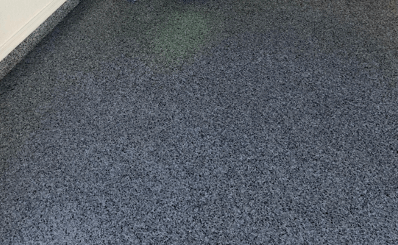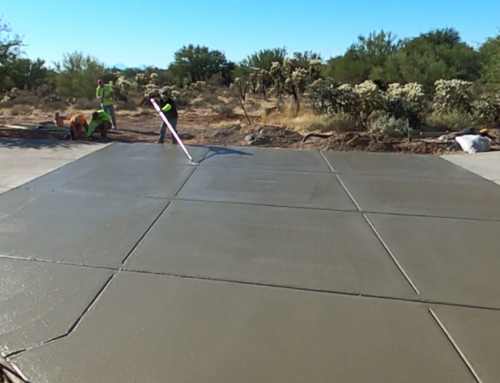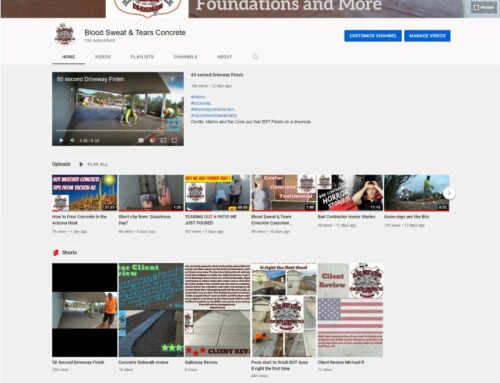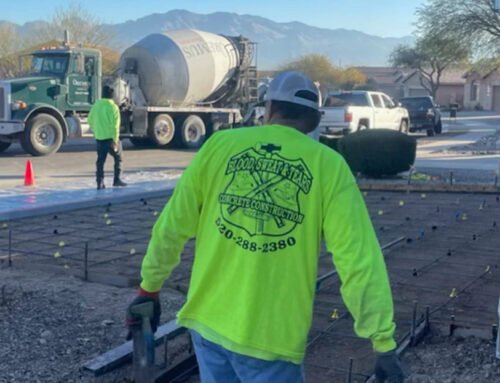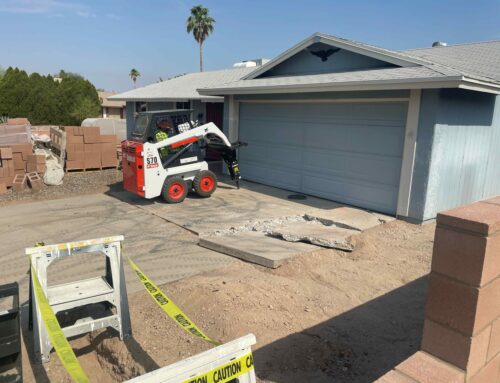It looks really cool and it seems like it would be easy to clean. Are there many color options? Can I do it myself? How long does it last? What do I need to know about Resinous Concrete Coatings?
Resinous garage floor and driveway coatings are very popular now and come in many colors. Having a top quality coating professionally installed is nice but it can be really expensive! Why would you pay that kind of money for something so simple? Painters, handymen and homeowners are installing them all over town… What could go wrong? Let’s take a look….
There are four parts to a resinous floor coating here in Tucson. An additional coat known as the vapor barrier may be required in some parts of the country:
Crack repair product:
Most floors have small cracks that need to be repaired prior to coating. A mixture of silica sand and crack repair material are worked into the void once the crack is opened up with a specialty grinder and cleaned. The surface is ground smooth once the repair product hardens. With flakes applied at 100% coverage the cracks blend in well but may still be visible at certain angles in the right lighting.
Color coat(s):
The color that first goes down on the floor soaks right in making it dry pretty fast. The flakes can be cast into this coat but need to be cast very quickly so they will adhere to the floor. If two color coats are applied the second coat will assure a much longer window to cast chips that stick properly.
Flake coat:
Flakes, also called chips, are cast into the still wet first or second color coat. They can be applied sporadically (feeding the chickens) or with 100% coverage so the only bits of color coat you see are what soak around the edges of the flakes. Feeding the chickens takes practice for the perfectionist eye.
Top coat(s):
Clear Product such as epoxy, Polyaspartic or Poly 90. The poly top coats are UV stable and several times harder than epoxy. Which one to use is all about the circumstances of the job. Top coats work well if one person puts product down with a squeegee while others back roll with a paint roller.
When installing resinous chip coatings, research the following: The solids in your product, the Ultra Violet stability, Proper Crack repair, the amount of product going on the floor and Prep. The most important of all is the prep.
Prep:
There are 3 acceptable methods of prepping for a coating. Grinding, shot blasting or a deep acid etch. The finished product is only as good as the prep. A rough profile is required from wall to wall. Any spots that are not properly profiled or left dirty will eventually let loose.
Crack repair can often times be the hang up for the DIY type. It takes practice and a few specialty tools like a grinder/vac to get it right.
A high solids product Like Graniflex covers completely in one coat and will not shrink while drying. Even though you can cover in one coat a professional installer will often thin out the first coat and send it deep into the pores of the floor for the ultimate adhesion. The chips will be cast into the slower drying second color coat with 100% chip coverage. Once the chips are properly scraped and prepped two UV stable Poly top coats are applied.
The downside of concrete coatings are few but need to be addressed in order for this article to be complete, and not just an advertisement for concrete coatings.
-UV stability: When it comes to the sun doing damage, the good folks of Arizona know all about it. Epoxy topcoats are great to work with and look outstanding when they first go down. Inside of a garage with doors that stay closed or are north facing, epoxy can look good for many years. If the door is open a good part of the time, and the garage floor has exposure to the sun, the epoxy will eventually amber. Some epoxies are better than others but given enough time, with enough UV exposure, it is inevitable. Stick with poly topcoats if your coating will see much sun.
-Concrete lifespan: You aren’t going to read about this in the literature you get from the coating companies and I’m sure they will not like me for saying it. I have made this observation over the years and even though I haven’t put it through scientific testing, or had the findings scrutinized by my peers, I am confident in my own two eyes. Coatings can shorten the overall life of your outdoor concrete in Arizona… There I said it!
When the coating is new it keeps the rain from even touching your concrete and stops all erosion from happening. Unfortunately, as time goes by and the coating breaks down, the rain gets through. The concrete gets wet and stays wet much longer because it is under the coating. Comparing driveways that have been coated for 20 years to driveways that have never been coated in the same sub-division, it is my conclusion that the coated driveway in many cases, fails first. The damage is usually worst in the bottom sections of the driveway where the water flows to. When we remove the concrete it crumbles and often appears wet deep inside. Garage floors are under a roof and do not have the same problem.
-Re-coat fatigue: When we apply the first coat we like to thin it down to make sure it can get deep into the pores for maximum adhesion. If that coating should happen to fail down the road, the second coating will never adhere as well as the first. The simple reason is that the pours of the concrete have been filled and even if a deep grind is done there will most likely be coating left behind that keeps the new product from penetrating.
-Do it yourself: Besides the specialty tools like respirators, a properly filtered vacuum, grinders with dust collection shrouds and spike shoes, the Coating contractor has most likely been through training on how to manage time. Most do it yourself kits from the big box store will require one color coat to be quickly applied, a fast smattering of chips and 1 coat of clear epoxy. Be sure to watch how to videos online before jumping into it if this is the route you are looking to take. If prepped properly, your diy coating can hold up for a while but there isn’t a lot of material to wear.
In conclusion: Think long and hard before spending your time and money on a do-it-yourself kit. Consider doing it right the first time by hiring a fully trained, reputable installer that knows coatings and what makes them stick.
Thank you for taking the time.
Jon Molden
Blood Sweat & Tears Concrete

